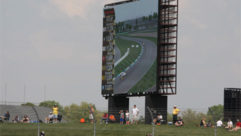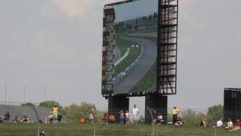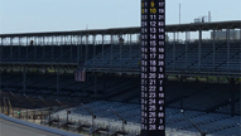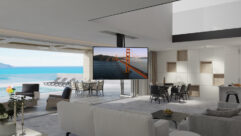
INSTALLATION: Indianapolis Motor Speedway
Feb 18, 2004 12:00 PM,
Robilard Nevin
Hurtling around the track in a Marmon Wasp at what was then
considered a scorching speed of 74.59 mph, Ray Harroun was the winner
of the first Indianapolis 500 in 1911. Since then top speeds at the
legendary Brickyard have eclipsed Harroun’s by an order of magnitude
three times as great, and the winner’s purse has skyrocketed from
$14,250 into the seven-figure range. The number of fans viewing the
event has grown exponentially, as well, with millions now being able to
tune in worldwide thanks to the power of television.
Despite faster cars, bigger money, and mass communications, however,
get on down to where the rubber meets the tarmac, and the configuration
of Indy’s 2-1/2-mile track essentially remains the same today as it was
nearly a century ago, a fact that fares well with traditionalists yet
has presented its share of challenges in terms of viewing events from
the speedway’s grandstands. Not necessarily built with spectator
viewing in mind but rather testing the limits of men and race cars, the
track’s long straightaway and sinuous turns have, until recently,
afforded each grandstand location with only a glimpse of the total
action. Fans seated along the straightaway, for example, obtained a
commanding in-your-face view of the action in front of them, but once
the cars disappeared into the first turn, they remained clueless of who
was holding the lead until the cars ripped past again. The same held
true for those seated elsewhere. Their view of what was taking place
was limited to only that which unfolded directly before them.
What forever changed how fans in the grandstands witnessed the race
was a multiphase video upgrade implemented during a three-year period
extending from 1999 to 2001. During this time,
18 large-screen video displays were custom-fabricated by Brookings,
South Dakota–based Daktronics and installed at a ratio of 7
within the infield and 11 on the inside and outside of the main
straightaway. Measuring in size from 29 feet by 23 feet to 9 feet by
10-1/2 feet, the video boards all utilize LED technology and, in many
instances, incorporate matrix displays providing text messaging and
three-sided, rotating ad panels.
Chosen to provide the sizable screens based upon research conducted
by Indy’s own engineering design department and a real-world shoot-out
conducted at the track attended by a number of major players within the
display industry, Daktronics is widely known for display technology
ranging in size from portable traffic warning/construction signs to the
huge scoring and video systems seen in NFL stadiums across the
country.
“When we first began exploring the idea of bringing video to the
speedway, we understood its intrinsic value,” says Dave Dusick, Indy’s
technical coordinator of multimedia systems during the video project
and subsequent audio upgrade. “What we didn’t realize was how well it
would be received at our facility. The response was truly amazing,
because for the first time in history, fans in the grandstands were
able to see every inch of every lap. Now someone seated in turn three
can watch cars battle into the turn right in front of them. Then as the
cars disappear from view, they merely turn their attention to the large
screen video displays to watch the action all the way around the rest
of the track.”

Serving as sources for viewing replays, highlight reels of past
races, postrace interviews, and a variety of independently produced
spots, the large screen displays receive live, race-action programming
courtesy of a raw feed supplied by IMS Productions. An Indy-owned and
-operated entity that keeps in excess of 20 cameras aimed upon the
action, IMS Productions additionally serves as the source for all
broadcast feeds.
“The video screens opened up a whole new world of opportunity in
terms of entertaining race fans,” Dusick says. “Beyond that they also
underscored an increasing need for improvements in track audio. Our old
P.A.-style sound seemed out of place in relation to the dynamic
programming seen on the screens. The more we examined the situation,
the more we concluded it was time to add audio that would further
define our new requirements for entertainment value.”
As a way of selecting the proper components that would bring better
audio definition to the track, Indy’s engineering and design team
relied upon the same model used for choosing the video, scheduling a
demanding product shoot-out in April 2002 with the aid of Dallas-based
WJHW. With just about every major audio manufacturer on hand to strut
its stuff, the shoot-out ultimately concluded with 325 ISIS Series
102W-DD enclosures from QSC being selected as the basic building blocks
for the upgrade.
First introduced to the project through AV Marketing, a local
independent manufacturer’s rep firm, the two-way QSC boxes were
actually latecomers to the selection process. Despite this handicap,
they bested all rival contenders for the job and emerged victorious
within the system’s blueprint mounted atop the speedway’s catch
fence. Supported as needed with 40 ground-stacked model 215SB-DD subs
also from the ISIS line, the audio system continued taking shape
following an unprecedented path, relying upon components culled from
the QSC catalog to the exclusion of virtually all others.
As the central players in the ISIS cast at Indy, the 102W-DD
loudspeakers are multipurpose devices featuring active or passive
crossover operation. Employing an advanced composite construction and
stainless-steel grilles, the enclosures offer strength, weather
resistance, and reduced weight–a combination of plus features for
places like Indy where they are exposed to the elements in fencetop
mounting positions. Serving as ideal mid/high counterparts to the ISIS
215SB-DD subwoofers, the boxes produce high output and extended range
thanks in no small part to internal components, including a 1.4-inch
exit, 3-inch titanium diaphragm compression driver, and a 10-inch
ferrite woofer. Additionally outfitted with a 150–by-50 waveguide
high-frequency section that can be rotated according to coverage needs,
the loudspeakers are further complemented by a full assortment of
hardware, including L-track mounting provisions at top and bottom to
make the task of rigging and installation as straightforward as
possible. A built-in stand-socket completes the design, along with a
distinct multiangle cabinet configuration, making it useful even in
monitoring applications.
Notable as the subwoofers with a high output-to-size ratio, Indy’s
ISIS 215SB-DD extended low-frequency cabinets are constructed using the
same carbon fiber/composite manufacturing techniques as their
full-range ISIS brethren. Just as lightweight and durable within the
confines of subwoofer operation, the rigidity of the tough manmade
material has the added benefit of raising the enclosure’s natural
resonances to frequencies higher than its normal operating range. At
the heart of the cabinet’s ground-shaking capabilities lie dual 15-inch
drivers each rated at 1,400W apiece. Mounted inside the ported cabinet
facing each other, the individual transducers deliver output
counteracting one another, producing significantly less enclosure
vibration while delivering smooth, low distortion performance and
considerable wallop.
When the Indy design team set about to examine loudspeaker options
during the shoot-out, they were essentially seeking devices with a core
group of basic attributes providing premium audio in a compact package
that wouldn’t impact spectator and television sightlines.
“There were a lot of boxes that sounded great,” Dave Dusick says.
“But only QSC really met both our sightline and performance needs. The
ISIS cabinets have a response totally unlike what you’d expect from
such a small box. They handle music and speech equally well and even go
as low as 70 Hz, a fact which allowed us to reduce the number of
subwoofers used on the project.”
Dusick and the Indy staff labored long and hard when it came to
determining how the ISIS loudspeakers would be mounted. Researching
every design option available, they wound up giving a unison veto to
ideas of a rear-firing system mounted on poles behind the grandstands
and just about any other configuration one could possibly imagine.
“Because of the way our facility is laid out, nothing outside of what
we finally settled upon really fit when it came to deploying the
loudspeakers,” Dusick says. “For example, a centralized cluster mounted
within the infield atop the Daktronics video screens wouldn’t have
worked because of the distances involved. Conversely, anything with
poles would work against everything done over the years to maximize
sightlines. When all was said, done, and thoroughly researched, all
that was left as an option is what we did.”
Utilized as portable reinforcement for a grandstand area often moved
about to accommodate different racing events, 30 of QSC’s AD-S82
cabinets merge with the ISIS full-range components to help complement
the design. “Right from the beginning, we knew the loudspeakers were
going to be vital to the system’s success,” Dusick says. “Once we made
our final choices in this area, we began our search for amplification
and control. In the end, we decided to go with QSC for these
components, too. Our goal is to have this system in place for the next
20 to 25 years, so having a single manufacturer standing behind
everything is something definitely to our advantage.”
Residing within 14 equipment rooms located around the 2-1/2-mile
track, 125 CX1102, 3 CX1202V, and 52, 4-channel CX404 amplifiers rally
to bring power to the Indy system. Linked at their wide-ranging and
often distant locales by QSC’s CobraNet-based Routing Audio via
Ethernet (RAVE) network, the amps all gain the added benefits of
QSControl monitoring and control. A single RAVE 188 serves as the
transmitting hub, with signals traveling through fiber to receiving
RAVE 188 units in each amp room. Every signal leaves the system headend
within the digital domain and is converted back to analog before
reaching the amps with the aid of QSC’s CM16a amplifier network
monitors. From the amplifiers, signals travel to the loudspeakers over
standard No. 10 copper.
Back in the day when what Dusick describes as a “70V system on
steroids” ruled the Indy roost, the only truly effective way to
validate system loudspeaker function was to borrow a track vehicle and
drive to the location of each. Failing to miss that ritual even a
little bit after he obtained the keys to the new rig, Dusick notes that
one of the best things about QSControl is that it enabled him to
monitor every breath of the entire Indy system, loudspeaker runs in
excess of a mile notwithstanding. “There’s more flexibility with
QSControl,” he says, “especially in terms of control, as it allows
channel-specific adjustments on individual loudspeakers via one of 225
amplifier-mounted QSC DSP-3 processing units. There’s no such thing as
location constraints anymore, because now you can tune a loudspeaker
according to the particular acoustic needs of wherever it’s mounted.
Right from the QSControl screen, you can provide optimal processing for
a loudspeaker under a grandstand roof, out in the open atop the catch
fence, or wherever. The technology takes the subjectivity out of
tuning, as well, as now you can precisely monitor voltage and current
and understand just what the data means.”
Final construction phases of the system began in fall 2002, with
work continuing unabated through the Midwest’s cold winter months and
coming to a close well before Indy 500 activity kicked into high gear
on the first of May.
“The system made its first sound during the third week of March and
was completely online in the beginning of April,” Dusick says. “It all
came out better than I expected. A lot of people put everything they
had into this project, and the results have proven to be nothing less
than totally rewarding.”
Dusick likens the pace of the A/V component of race day to that of
any megaevent TV production. “Beyond serving as a medium for the race
announcements and action itself, audio and video programming fills in
to entertain the crowd with segments ranging anywhere from 15 to 20
seconds in length on up to three or four minutes,” he says of the
electronic portion of the show. “Indy’s philosophy has always been to
give the crowd more than they bargained for. The screens are constantly
lit up, and sound fills the stands. In addition to the race, the fans
get bits of history, music, all kinds of things to keep the action
moving and make it a better experience. On a historical level at Indy,
these systems may have been 90 years in the making, but they were
definitely worth the wait.”
Assisting the Indianapolis Motor Speedway engineering and design
team on the audio project were local electrical contractor Miller-Eads,
which pulled and terminated more than 300,000 feet of No. 10 copper for
the loudspeaker runs; Indy-based Clawson Communications (which did all
of the fiber); headend designer Durrell Audio of Nashville (which,
among many assigned tasks, added a new Crest X-Eight 32 input console
to the main control room); and TA Electronics, a firm owned by longtime
Indianapolis audio contractor Tom Allebrandi, which wired all the
racks.
Held on Sunday, May 25 last year, the Indianapolis 500 was one of
three major events taking place at the Indianapolis Motor Speedway
between May and October. The Brickyard 400 followed on August 3 and
then the United States Grand Prix on September 28. Kevin Harvick
emerged victorious at this year’s Brickyard 400, and Michael Schumacher
resided in the winner’s circle at the conclusion of the U.S. Grand
Prix. Gil De Ferran won his first Indy 500 in May, stealing the race
from teammate and returning champion Helio Castroneves.
U.K.–expatriate–turned–Hoosier and motor-sports
addict Robilard Nevin is an acoustical design engineer living and
working in Indianapolis.









